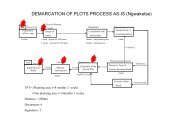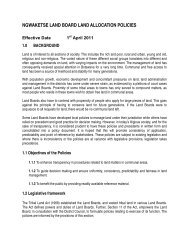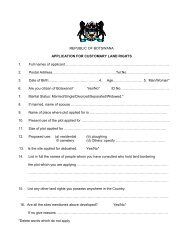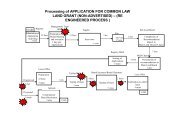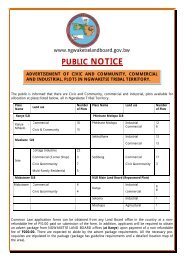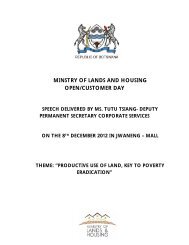District Intergrated Land Use Plan - Ngwaketse Land Board
District Intergrated Land Use Plan - Ngwaketse Land Board
District Intergrated Land Use Plan - Ngwaketse Land Board
You also want an ePaper? Increase the reach of your titles
YUMPU automatically turns print PDFs into web optimized ePapers that Google loves.
CHAPTER 1<br />
INTRODUCTION<br />
1.3.4 The Tribal <strong>Land</strong> Act at Section 17(4) provides that “After consultation with the district<br />
council, village development committee, tribal authorities and any other interested<br />
institutions, the land board may determine management plans and their revision from time<br />
to time, for the purpose of assisting or giving guidance on the use and development of such<br />
land use zone within a tribal area”.<br />
1.3.5 By logical extension, both the <strong>Ngwaketse</strong> and Rolong <strong>Land</strong> <strong>Board</strong>s require an integrated<br />
land use plan which will guide the rational utilisation of land within the district. This in effect<br />
makes the SDLUP an important tool in the decision making of the two <strong>Land</strong> <strong>Board</strong>s.<br />
1.3.6 The National Policy on Tribal Grazing <strong>Land</strong> (Government. Paper No.2 of 1975) under Part<br />
V: The Rules for Zoning, Allocation and Leases, require the <strong>Land</strong> <strong>Board</strong> to zone tribal<br />
grazing land. Under the policy, tribal grazing land is zoned for communal grazing,<br />
commercial grazing and reserved grazing land to accommodate future farmers.<br />
1.4 PURPOSE OF THE PLAN<br />
1.4.1 The main purpose of the Southern <strong>District</strong> Integrated <strong>Land</strong> <strong>Use</strong> <strong>Plan</strong> (SDILUP), is to provide<br />
a single unifying document that will guide and shape land and other resources utilisation<br />
and development in a rational, equitable, sustainable and balanced manner throughout the<br />
entire district. Equally important, the plan is meant to serve the following purposes:<br />
(i) It is expected to provide a solid practical guide to decision making processes and<br />
implementation of land use activities.<br />
(ii) It should provide a basis for land use zoning and allocation to the <strong>Land</strong> <strong>Board</strong>s<br />
and Subordinate <strong>Land</strong> <strong>Board</strong>s in the district.<br />
(iii)<br />
(iv)<br />
(v)<br />
(vi)<br />
(vii)<br />
The plan also translates, supplements and implements National, Regional and<br />
<strong>District</strong> policies, programmes, strategies and plans.<br />
It will be a source of information about the district from a planning and<br />
development perspective.<br />
It is expected to be used by the Central Government, Local Authorities and<br />
Parastatals to coordinate land use activities in the district.<br />
It will help identify sub regions that are poorly endowed and examine ways to<br />
improve the situation, thereby assisting in bridging the gap between the less<br />
endowed areas and the more endowed areas of the district.<br />
It will provide a framework for the promotion of conservation of natural resources for<br />
the benefit of present and future generations.<br />
1.5 UNDERLYING PRINCIPLES, APPROACH AND METHODOLOGY<br />
1.5.1 A number of principles underpin the preparation of the SDILUP. These include the following:<br />
(i)<br />
(ii)<br />
Procedural Fairness – in preparing the plan, the people who could be potentially<br />
affected by a decision will be given an opportunity to participate in the planning process.<br />
Consultation Before Action – public involvement is considered a fundamental<br />
requirement in the preparation of the SDILUP. The purpose is to develop planning<br />
products that, to the greatest extent possible, are based on substantial effective<br />
agreement on a course of action. <strong>Plan</strong>ning recommendations that are supported by<br />
a wide range of interests generally result in more durable decisions.<br />
4 REPORT OF SURVEY



